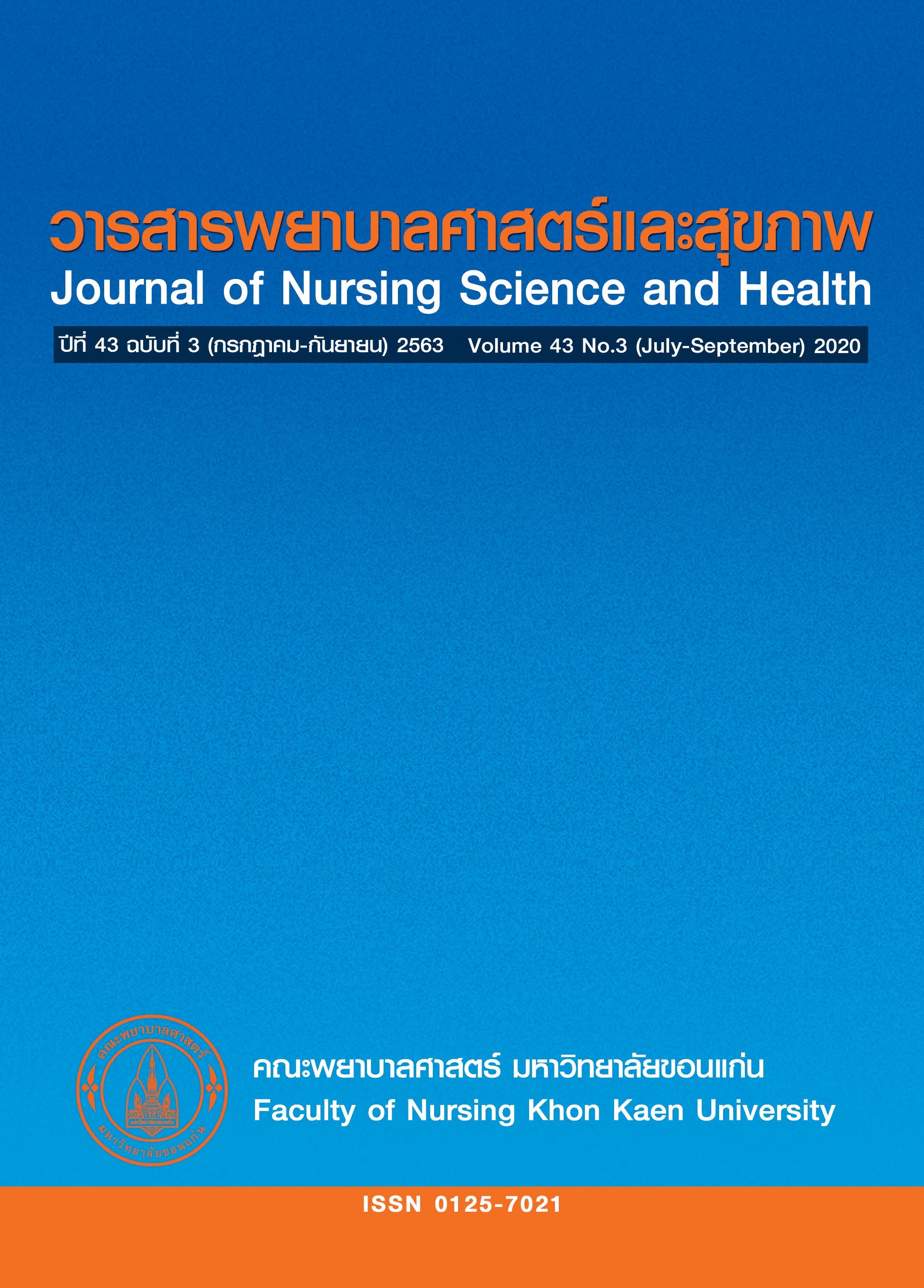ภาวะโภชนาการและความสัมพันธ์กับการเกิดแผลกดทับใหม่ในผู้ป่วยที่รับย้ายจากหอผู้ป่วยในเข้ารักษาต่อในหอผู้ป่วยวิกฤต
คำสำคัญ:
ภาวะโภชนาการ คะแนนบราเดน แผลกดทับบทคัดย่อ
การศึกษาย้อนหลังเพื่อศึกษาภาวะโภชนาการและความสัมพันธ์กับการเกิดแผลกดทับใหม่ในผู้ป่วยที่รับย้ายจากหอผู้ป่วยในเข้ารักษาต่อในหอผู้ป่วยวิกฤต 92 ราย โดยใช้แบบประเมินภาวะโภชนาการชนิด Nutrition Alert Form (NAF) และแบบประเมินแผลกดทับบราเดน (Braden scale) ผลการศึกษาพบคะแนน NAF ระดับเอ 56 ราย (ร้อยละ 52.3) ระดับบี 32 ราย (ร้อยละ 29.9) ระดับซี 19 ราย (ร้อยละ 17.8) พบความสัมพันธ์ระหว่าง ปัจจัย ได้แก่ ภาวะโภชนาการเดิม ประเภทผู้ป่วย และ คะแนนบราเดน มีความสัมพันธ์กับการเกิดแผลกดทับใหม่ (p<.05) ภาวะทางด้านโภชนาการในกลุ่มผู้ป่วยวิกฤตมีความสำคัญ ดังนั้นทีมสุขภาพควรให้ความสำคัญของโภชนาการควบคู่ไปกับการรักษาโรคที่เจ็บป่วยวิกฤต
เอกสารอ้างอิง
Chittawatanarat K. Health intervention and technology assessment (HITAP). [on internet]. 2013. [cited 2020 Jan 5]. Available from: http://www.hitap.net.
Bhirommuang N, Komindr S, Jayanama K. Impact of nutritional status on length of stay and hospital costs among patients admitted to a tertiary care hospital in Thailand. Asia Pac J Clin Nutr 2019; 28(2): 252-9.
Shin JC, Chang SH, Hwang SW, Lee JJ. The nutritional status and the clinical outcomes of patients with a spinal cord injury using nutritional screening tool. Ann Rehabil Med 2018; 42 (4): 591-60.
Changyai K. Continuous nutritional care practice in critically ill patients. Nurs Health Care 2018; 36(4): 25-32.
Sanrang P, Putwatana P, Kuwatnasumrit K, Sumritpradi P. Nutrition support and clinical outcomes in surgical critical patients. Rama Nurs J 2012; 18(3): 343-54. (in Thai)
Horn SD, Bender SA, Ferguson ML, Smout RJ, Bergstrom N, Taler G, et al. The national pressure ulcer long-term care study: Pressure ulcer development in long‑term care residents. J Am Geriatr Soc 2004; 52: 359-67.
Edsberg LE, Langemo D, Baharestani MM, Posthauer ME, M. G. Unavoidable pressure injury: State of the science and consensus outcomes. J Wound Ostomy Continence Nurs 2014; 41(4): 313-4.
Kanogsunthornat N. Pressure injury management [on internet]; 2019. [cited 2020 Febuary 10]. Available from: https://med.mahidol.ac.th/nursing/ACNER/admin/file_doc/20190813090819.pdf.
Qaddumi JAS, Almahmoud O. Pressure ulcers prevalence and potential risk factors among intensive care unit patients in governmental hospitals in Palestine: A cross-sectional study. Open Public Health J 2019; 12: 121-6.
Apostolopoulou E, Tselebis A, Terzis K, Kamarinou E, Lambropoulos L, Kalliakmanis A, et al. Pressure ulcer incidence and risk factors in ventilated intensive care patients. Health Sci. J 2014; 8(3): 333-42.
Shahin ESM, Dassen T, Halfens RJG. Pressure ulcer prevalence and incidence in intensive care patients: A literature review. Nurs Crit Care 2008; 13: 71-9.
Dongpho P. Effectiveness of clinical practice guidelines implementation for pressure sore preventation TMJ 2019; 19(2): 315-23. (in Thai)
Bootthumpan O, Lavin W. Association between risk factors and pressure injury patients in cardiac care unit : A retrospective matched-paired case control study design. Mahidol R2R e-Journal 2020; 7(1): 140-8. (in Thai)
Nualsrithong P, Katnimit C, Muansatit T. The results of using starch Tanaka powder in preventing pressure injury stage 1 in the elderly at male surgical ward at Vachira Phuket hospital. Reg Med J 2017; 31(1): 179-89. (in Thai)
Blanc G, Meier MJ, Stocco JG, Roehrs H, Crozeta K, Barbosa DA, et al. Effectiveness of enteral nutritional therapy in the healing process of pressure ulcers: A systematic review. Rev Esc Enferm USP 2015; 49(1): 150-9.
Chiari P, Forni C, Guberti M, Gazineo D, Ronzoni S, Alessandro FD, et al. Predictive factors for pressure ulcers in an older adult population hospitalized for hip fractures: a prognostic cohort study. Plos one 2017; 12(1): 1-12.
Vetrano DL, Landi F, Buyser SL, Carfì A, Zuccala G, Mirko Petrovic, et al. Predictors of length of hospital stay among older adults admitted to acute care wards: a multicentre observational study. Eur J Case Rep Intern Med 2014; 25: 56-62.
Lim ML, Ang SY. Impact of hospital-acquired pressure injuries on hospital costs -experience of a tertiary hospital in Singapore. Wound practice & research 2017; 25(1): 42-7.
Luevanich C, Luevanich R, Phonploy W. Tewsakul C. Factor related to pressure occurrence of hospitalized patients in Vachira Phuket Hospital. JTNMC 1999; 14(2): 17-29. (in Thai)
Krejcie VR, Morgan WD. Determining sample size for research activity. Educ Psychol Meas 1970; 30: 607-10.
Komindr S, Tangsermwong T, Janepanish P. Simplified malnutrition tool for Thai patients. Asia Pac J Clin Nutr 2013; 22(4): 516-21.
Buranakul A. Pressure ulcer risk factors among hospitalized neurological patients. [Master of Nursing Science, Adult Nursing] Nakorn Pathom: Mahidol university; 2002.
Tsaousi G, Stavrou G, Ioannidis A, Salonikidis S, Kotzampassi K. Pressure ulcers and malnutrition:results from a snapshot sampling in a university hospital. Med Princ Pract 2015; 24: 11- 6.
Cox J. Predictive power of the Braden scale for pressure sore risk in adult critical care patients: A Comprehensive Review. J Wound Ostomy Continence Nurs 2012; 39(6) :613-21.
Matozinhos FP, Melendez GV, Tiensoli SD, Moreira AD, Gomes FSL. Factors associated with the incidence of pressure ulcer during hospital stay. Rev Esc Enferm USP 2017; 51: 1-7.
Borghardt AT, Prado TN, Araujo TM, Rogenski NM, Bringuente ME. Evaluation of the pressure ulcers risk scales with critically ill patients: a prospective cohort study. Rev Latino-Am Enfermagem 2015; 23(1): 28-35.
Cox J. Predictors of pressure ulcer development in adult critical. AJCC 2011; 20(5): 364-74.
Ahtiala M, Soppi E, Wiksten A, Koskela H, Gronlund JA. Occurrence of pressure ulcers and risk factors in a mixed medical-surgical ICU-a cohort study. JICS 2014; 15(4): 340-3.
Seongsook J, Ihnsook J, Younghee L. Validity of pressure ulcer risk assessment scales; Cubbin and Jackson, Braden, and Douglas scale. Int J Nurs 2004; 41: 199–204.
ดาวน์โหลด
เผยแพร่แล้ว
รูปแบบการอ้างอิง
ฉบับ
ประเภทบทความ
สัญญาอนุญาต
วารสารพยาบาลศาสตร์และสุขภาพเป็นเจ้าของลิขสิทธิ์ในการเผยแพร่ผลงานที่ตีพิมพ์ห้ามผู้ใดนำบทความที่ได้รับการตีพิมพ์ในวารสารพยาบาลศาสตร์และสุขภาพไปเผยแพร่ในลักษณะต่าง ๆ ดังนี้ การนำบทความไปเผยแพร่ออนไลน์ การถ่ายเอกสารบทความเพื่อกิจกรรมที่ไม่ใช่การเรียนการสอน การส่งบทความไปตีพิมพ์เผยแพร่ที่อื่น ยกเว้นเสียแต่ได้รับอนุญาตจากวารสารพยาบาลศาสตร์และสุขภาพ



